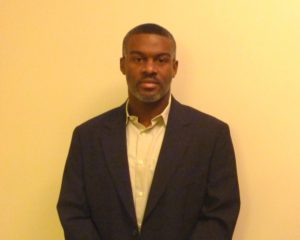
Electrical engineer Kevin Hurlock spends a lot of his time thinking about how electronics break and how to fix them. He grew up in Jamaica, where the high humidity in the air meant that his father’s electronic music equipment, like speakers, amplifiers and synthesizers, would break often. His father taught him to solder—to melt soft metal onto two other metal parts to make an electrical connection between them—when he was just eight years old. A couple of years later, young Kevin was helping to repair his father’s electronics, then repairing them on his own.
As electronic music became more digital and less analog—using small computers to create sound effects rather than just passing sound signals through simple circuits—Hurlock helped his dad with the new devices. He had always liked to look up things in the encyclopedia, to read manuals. and to figure out how to use new tools. He also watched documentaries on the history of electronics and communications. Between the ages of nine and 14, Kevin was already replacing fuses in amplifiers and coils (which create sound by initiating an electrical field) in speakers. He also explained to his father how to use the new software that his increasingly sophisticated musical equipment required.
Hurlock’s childhood hobby continued to interest him in high school, when he took a physics class with a teacher who was infamous both for his harsh discipline and for the excellence of his teaching. Hurlock studied hard for all of the topics in the class, but he did especially well in electromagnetic physics and optics—not a surprise, given all of the experience he already had.
Today, Hurlock works on the electronics in cars. He figures out why and how often the systems fail, helping the company he works for, Panasonic, keep its cars safe and reliable. A large part of his work involves statistics: he must estimate the number of cars that will have electronics problems in any given sample of cars. This number is ideally very low: it’s commonly measured in ppm, or parts per million. An electronics problem that has a ppm of 100, for instance, shows up, on average, in just one car in 10,000 (100:1,000,000 = 1:10,000).
Part of Hurlock’s job is to make problems happen less often, and to limit the impact of unavoidable problems on drivers. If he finds, for example, that a touchscreen used in the car sometimes has problems with one corner of its display, he may suggest placing something over that part of the display that’s used only rarely, like the button for switching to AM radio. When he finds a safety problem, though, Kevin accepts no ppm at all. Safety comes first.
When customers complain about the reception on their car radios, Hurlock and his colleagues use a spectrum analyzer to examine the radio and other signals available in their area. Spectrum analyzers check different frequencies, from those of satellite radios and cell phones (which have higher frequencies) to regular radio signals. They help cell phone companies figure out whether there’s room at a given frequency for a new signal. And they help Hurlock make sure that the signal on a car radio is clear as the car moves through different areas.
Electrical engineers use many sophisticated tools. When he worked at Honda as a test engineer, Hurlock used oscilloscopes, which measure current, voltage or resistance very precisely over time. They helped him determine whether cars could handle the demands of real-life driving. And they helped him perform “dark current tests.”
When a car’s owners go on vacation, leaving the car behind, they expect it to have enough energy stored in its battery to start the car’s engine when they return. Hurlock and his colleagues at Honda used math and physics to measured exactly how much power was being used by each component of a car. This is sometimes more than zero even when the car is turned off (when it’s “dark”). The clock, for instance, has to keep running, even when no one is driving the car. Hurlock made sure that each part wasn’t drawing any more power than it was rated to draw, so that the car’s battery would not die and the car would start when its owner returned.
Great progress is always being made in the car industry, according to Hurlock. “Ten years ago, you’d have a wire connected to the gas pedal of your vehicle.” Now much more sophisticated electronics, including fiber optics, make cars more reliable.
“You have to love what you’re doing,” Hurlock advises students choosing future careers. He recommends reading science magazines if you’re interested in electrical engineering. You might start with one of the magazines Hurlock himself enjoys: Car and Driver, National Geographic, Popular Science and Popular Mechanics. Hurlock’s curiosity and his ability to rise to the challenges of demanding teachers and changing technology has helped him build a career that makes his own life — and the lives of his customers — more satisfying.

